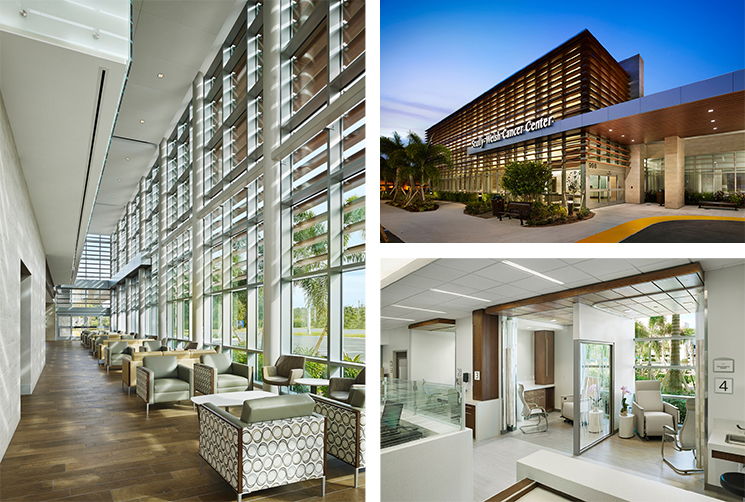Array Architects’ design team is proud to announce their award receipt in Modern Healthcare’s 32nd Annual Design Awards for the Scully-Welsh Cancer Center at Indian River Medical Center in Vero Beach, FL.
The design team at Array Architects’ Philadelphia office, led by Kent Doss, AIA, LEED AP, Lean Six Sigma Black Belt, collaborated with the leadership and oncology clinical teams at Indian River Medical Center to create a healing outpatient environment for the care of cancer patients receiving both radiation and infusion services in the Vero Beach, FL area. “This community hospital, with about 300 beds, is now able to provide their constituents with care in the community – a real game-changer for this growing retirement area near the coast,” said Jonathan Bykowski, AIA, Lean Six Sigma Black Belt, Array’s lead planner on the project.
In 2012, Array teamed with Indian River to create an integrated, multi-specialty Health & Wellness Center on the main campus. In 2013, Indian River selected the same design team to bring a new Cancer Center to the community. Array led the development of a 20,000 SF addition to expand and integrate the existing Radiation Oncology pavilion, creating a new arrival experience. The Cancer Center features multi-modality clinics, integrated treatment planning, infusion, radiation therapy, resource and education programs, and access to clinical trials and research.
Noted in Modern Healthcare’s article announcing the annual awards winners, Designing for an Uncertain Future, the Scully-Welsh Cancer Center is recognized for extending the facility into the outdoors to benefit patients, staff, and visitors. A healing garden links the Cancer Center and Health & Wellness Center creating a respite place for patients and families as well as an activated connection for physicians and staff between the facilities. The facility establishes the Center’s brand for the expanded cancer program through the design of both the patient experience and the built environment. Together the Cancer Center and the Health & Wellness Center form a new outpatient anchor of the campus.
The Cancer Center was designed using Lean Design and Operational principles to ensure maximum efficiencies for delivering patient care. During the conceptualization and development phases of the project, the design team was led by Array’s healthcare planners who are all Lean Facilitators helped guide the reimagining of cancer care within the Indian River community in a way that ensured treatment met outcome goals and remained sustainable in a challenging healthcare environment. Lean Design practices were used by the team to conceptualize and validate operational processes so they could ensure the project was accurately sized to meet the actual needs of the caregivers and patients. Working through current and future states with the oncology staff allowed the Center to ultimately reduce patient wait time during infusion appointments by an hour.
The main lobby is articulated as a double-height, glass-enclosed nexus that enables enclosure, which invites those waiting in lounges on both floors to take in views of the surrounding landscape. The design includes carefully positioned louvers to both allow uninterrupted views while preventing solar penetration. From the lobby, an array of patient education and respite resources are provided along a concourse providing access to the healing garden, which includes areas for group socialization and individual solitude for both patients and staff.
In the treatment zones, each exam room and infusion bay is positioned to have evidence-based, outcome enhancing views out into the natural landscape. The ground floor infusion bays also have easy access to the healing garden so patients who are well enough can choose to have their treatment outdoors. A natural materials palette that incorporates locally informed references is seamlessly blended between the exterior and interior spaces. The metaphorical merging of these environments is expressed in the main lobby as the horizontal solar control louvers penetrate the interior and “twist” to become interior wood paneling, which in turn wraps the lobby and runs back outside to become the rain screen siding of the garden facades.
In addition to utilizing locally sourced and environmentally responsible materials wherever possible, the project design incorporates three significant ecological strategies. The first strategy was a utilization of Lean principles to “right size” the project. By accurately tuning the project program and design to the specific needs of the patients and care protocols, the design team reduced the constructed area of the project by approximately 10% from the initial area forecast. Savings were further enhanced by the team’s efforts to incorporate existing linear accelerator vaults into the facility design instead of demolishing and replacing them.
Another area of focus for the design team was limiting the long-term operating energy footprint of the facility. While the hospital’s existing central energy plant (and therefore the origin of the energy) was outside of the project scope, the team selected materials, systems, and equipment with efficiency as a driver, meeting or exceeding ASHRAE standards. One area that illustrates the team’s approach is the two-story glass lobby. The articulation of the design required significant study to eliminate solar heat gain from the south-facing glass in the project’s harsh subtropical climate and protect sensitive patients from direct sunlight while simultaneously allowing views out to the lush, natural landscape. The shading system employed has proven effective from both a spatial/experiential perspective and an environmental comfort/efficiency perspective.
Finally, and most importantly for this project, the overall impact of delivering treatment to the hospital’s community has been reduced by providing care within the community. Before construction of the Cancer Center, patients in need of treatment were forced to travel significant distances to obtain quality care. By providing community-based care integrating state-of-the-art telehealth consultation from leading practitioners and researchers from Duke University, Indian River Medical Center is leading the charge to manage population health.





